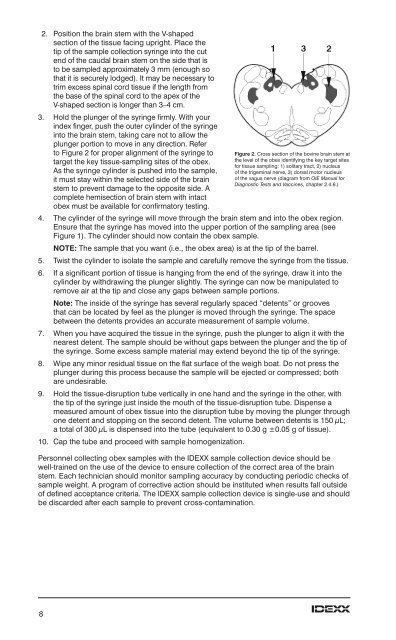HerdChek* BSE-Scrapie Antigen BOVINE SPONGIFORM ... - Defra
HerdChek* BSE-Scrapie Antigen BOVINE SPONGIFORM ... - Defra
HerdChek* BSE-Scrapie Antigen BOVINE SPONGIFORM ... - Defra
You also want an ePaper? Increase the reach of your titles
YUMPU automatically turns print PDFs into web optimized ePapers that Google loves.
2. Position the brain stem with the V-shaped<br />
section of the tissue facing upright. Place the<br />
tip of the sample collection syringe into the cut<br />
end of the caudal brain stem on the side that is<br />
to be sampled approximately 3 mm (enough so<br />
that it is securely lodged). It may be necessary to<br />
trim excess spinal cord tissue if the length from<br />
the base of the spinal cord to the apex of the<br />
V-shaped section is longer than 3–4 cm.<br />
3. Hold the plunger of the syringe firmly. With your<br />
index finger, push the outer cylinder of the syringe<br />
into the brain stem, taking care not to allow the<br />
plunger portion to move in any direction. Refer<br />
to Figure 2 for proper alignment of the syringe to<br />
target the key tissue-sampling sites of the obex.<br />
As the syringe cylinder is pushed into the sample,<br />
it must stay within the selected side of the brain<br />
stem to prevent damage to the opposite side. A<br />
complete hemisection of brain stem with intact<br />
obex must be available for confirmatory testing.<br />
4. The cylinder of the syringe will move through the brain stem and into the obex region.<br />
Ensure that the syringe has moved into the upper portion of the sampling area (see<br />
Figure 1). The cylinder should now contain the obex sample.<br />
NOTE: The sample that you want (i.e., the obex area) is at the tip of the barrel.<br />
5. Twist the cylinder to isolate the sample and carefully remove the syringe from the tissue.<br />
6. If a significant portion of tissue is hanging from the end of the syringe, draw it into the<br />
cylinder by withdrawing the plunger slightly. The syringe can now be manipulated to<br />
remove air at the tip and close any gaps between sample portions.<br />
Note: The inside of the syringe has several regularly spaced “detents” or grooves<br />
that can be located by feel as the plunger is moved through the syringe. The space<br />
between the detents provides an accurate measurement of sample volume.<br />
7. When you have acquired the tissue in the syringe, push the plunger to align it with the<br />
nearest detent. The sample should be without gaps between the plunger and the tip of<br />
the syringe. Some excess sample material may extend beyond the tip of the syringe.<br />
8. Wipe any minor residual tissue on the flat surface of the weigh boat. Do not press the<br />
plunger during this process because the sample will be ejected or compressed; both<br />
are undesirable.<br />
9. Hold the tissue-disruption tube vertically in one hand and the syringe in the other, with<br />
the tip of the syringe just inside the mouth of the tissue-disruption tube. Dispense a<br />
measured amount of obex tissue into the disruption tube by moving the plunger through<br />
one detent and stopping on the second detent. The volume between detents is 150 µL;<br />
a total of 300 µL is dispensed into the tube (equivalent to 0.30 g ±0.05 g of tissue).<br />
10. Cap the tube and proceed with sample homogenization.<br />
Figure 2. Cross section of the bovine brain stem at<br />
the level of the obex identifying the key target sites<br />
for tissue sampling: 1) solitary tract, 2) nucleus<br />
of the trigeminal nerve, 3) dorsal motor nucleus<br />
of the vagus nerve (diagram from OIE Manual for<br />
Diagnostic Tests and Vaccines, chapter 2.4.6.)<br />
Personnel collecting obex samples with the IDEXX sample collection device should be<br />
well-trained on the use of the device to ensure collection of the correct area of the brain<br />
stem. Each technician should monitor sampling accuracy by conducting periodic checks of<br />
sample weight. A program of corrective action should be instituted when results fall outside<br />
of defined acceptance criteria. The IDEXX sample collection device is single-use and should<br />
be discarded after each sample to prevent cross-contamination.<br />
8
















